Menu

Did you know that in Michigan, 243 robotic milking units work on 55 farms? This fact shows a big change in farming, moving towards more automation. Since 1992, when they started in the Netherlands, automated milking systems (AMS) have changed the game for dairy farmers. Now, farmers can spend more time on important tasks like looking after animals and making important decisions.
In Michigan, the benefits of AMS are clear. It helps save time and makes sure cows are happier. With 243 robotic milking units in use, more farmers are embracing this technology. These machines do more than just milk cows. They also collect health and nutrition data, which helps farmers take better care of their animals. But, switching to AMS is a big decision. It needs careful thinking about things like how easy it is to expand and the costs of upkeep.
The story of dairy farming shows how traditional and new tech mix. It started in 1860 with Lee Colvin’s milking pump in New York. Anna Baldwen later improved this with the “Hygienic Glove Milker” in 1879, making a big change. The pulsator in 1895 and Herberr McCornack’s Surge Bucket Milker in the 1920s showed how farming was moving forward.
By 1992, the Netherlands had the first automatic milking parlour. This was a big step that led to more farms using Automated Milking Systems (AMS). From 2000, when there were 800 AMS farms, to now with over 35,000 units, the change is clear. AMS lets up to 220 cows be milked per hour using robots.
At first, milking machines were slow to catch on, but the 1895 pulsator sped things up. Later, robotic milking not only cut labour costs but also increased milk. Cows can now be milked several times a day by machines. These modern systems also track cow health closely, checking things like weight and temperature. This is good for cow wellness and for farming’s future.
The use of AMS has also changed how farms are built and run. Buildings must fit in new tech and feed cows automatically. This saves on labour and cuts down on waste. It shows how farming is always evolving.
This progress has made dairy farming more efficient and forward-thinking. But, we must not forget how key tech is for this growth. And, we expect automated milking to keep leading us to new farming methods.
Automated Milking Systems (AMS) come with a vast range of benefits. They boost the effectiveness of dairy farming exponentially. This is through better use of labour, increased cow happiness, and detailed data gathering.
AMS greatly improves how well workers on a farm can use their time. Studies like the ones by Tse show that a farm with 85 cows could reduce its workforce by 20% with AMS. This effect is not just about fewer employees. It means the remaining workers can focus on more important jobs.
Automation in milking saves a lot of labour too. These systems work non-stop, milking cows without needing someone there all the time. This lets farmers spend more time on other, more strategic work.
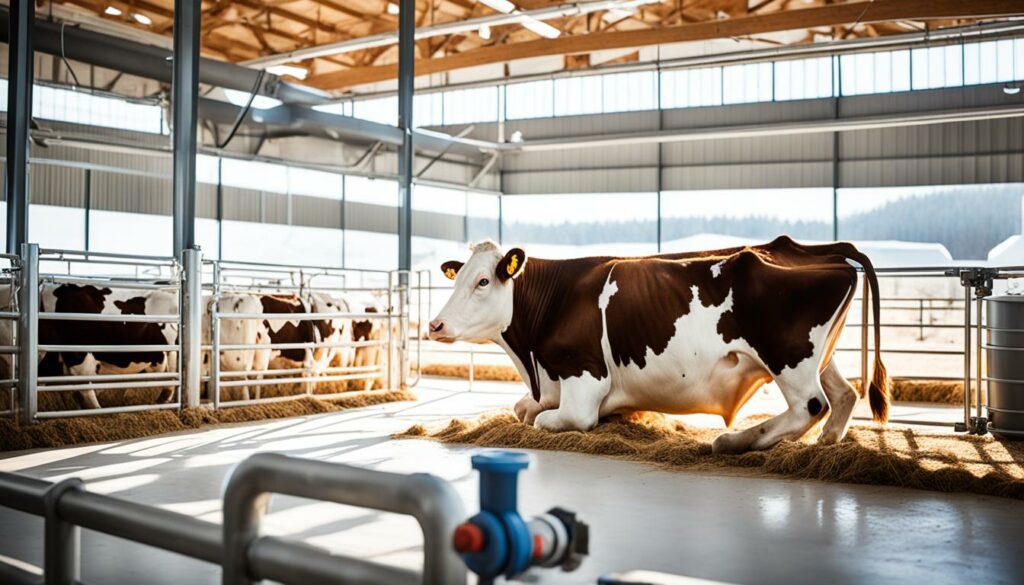
AMS also looks after the wellbeing of cows, which is crucial in dairy farming. These systems make sure cows have more space and time to rest, lowering their stress. The milking process is gentle and consistent, making cows more comfortable, leading to healthier, happier cows and better milk.
Lage’s research shows that nearly 77% of farmers adopt AMS to make their cows’ lives better. Many of these farmers agree that using AMS improves their cows’ conditions and, ultimately, their milk quality.
AMS completely changes how farmers can understand their operations. These systems provide tons of useful information. For example, the Lely Horizon app can help identify health issues in cows early, like mastitis.
With AMS, farmers can keep close tabs on their herd. They can track milk production, cow health, and what the cows eat. This information is vital for making decisions that make the farm run better and take care of the animals in the best way. Using this kind of data-driven farming is considered to be the way forward, aligning with the principles of precision farming.
Modern dairy farms are using robotic milking machines for many reasons. These machines use smart sensors and data analysis. They help dairy farms run better and more efficiently.
Automated milking systems keep track of key milk measurements like electrical conductivity. This helps make sure the milk is of good quality and the cows are healthy. Each system can work with about 60 cows. Some really good systems can handle up to 70 cows.
A single milking robot can cost from $150,000 to $200,000. This reflects the top-level technology and work that goes into making them. But, these machines are a big help on dairy farms. They cut down on the need for workers. They also help manage feed well, which cuts costs and waste.
Robotic milking systems work automatically. They check on the cows and the milk. This data is vital for good dairy farming and quick spotting of any cow health issues. It means less work for farmers and more time for other important farm tasks.
These machines can make cows feel less stressed. That’s because the cows get milked when they choose. This reduces how much cows interact with people. As a result, cows produce more milk because they are less stressed.
| Advantages | Disadvantages |
|---|---|
|
|
The information gathered by these systems helps make special feeding and care plans for each cow. This makes managing the herd better. But, these systems can face challenges. Some older cows might not like them. Also, the first cost is high.
In the US, dairy farms are getting more technology-focused. Using robotic milking systems can make dairy farming better and more sustainable. It could improve how well the dairy industry does in the future.
Investing in dairy technology, like automated milking systems (AMS), is key for the economy. A deep cost-benefit analysis is vital. It compares the money spent at first to the future savings and benefits.
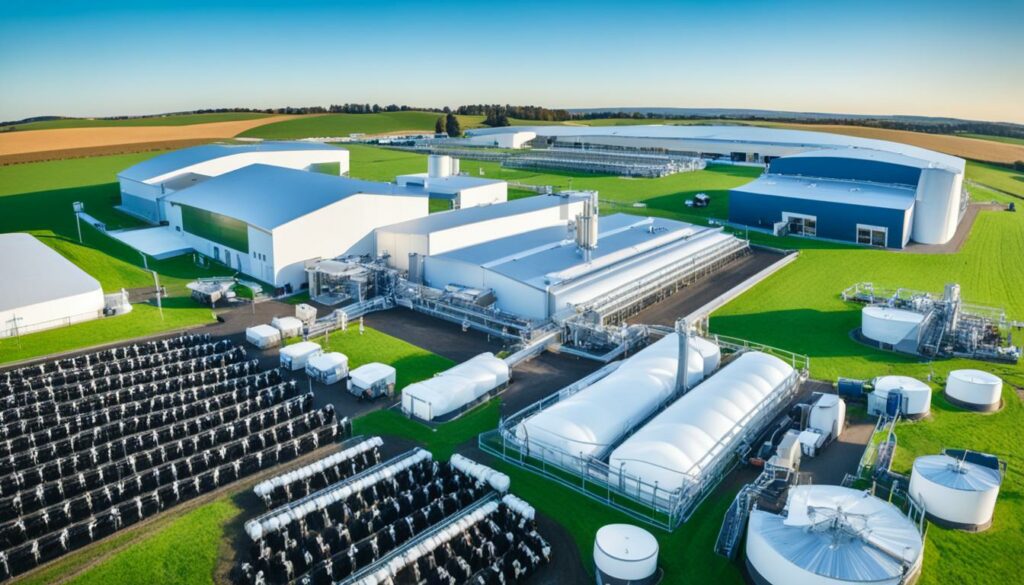
At first, automated milking systems cost about $200,000. This includes changing the farm setup. Even though it’s a big cost at the start, farms see savings over time. In places like Michigan, using AMS has shown many benefits. For example, farmers save on wages, about $1.5 for every 100 pounds of milk, through less work.
Using robotic milking means less work is needed. With AMS, the time spent milking goes down by 75%. This cuts the costs of running the farm. Farms with more cows save even more money, thanks to efficiency. Each robot can save a farm around $44,030 a year. This comes from saving time and needing fewer workers, which adds up to big savings for farmers.
Robotic milking also helps farmers manage their cows better. This can lead to cows producing up to 12% more milk than before. This boost in milk production is an advantage. It shows that, even though starting with AMS is costly, it pays off in the end. Robotic milking is a smart move for forward-thinking dairy farms. It helps them save money and make more milk.
The move to automated milking systems (AMS) has made big changes on many farms. This change is seen in the successful AMS integration on different dairy farms. For example, one farmer, Tina Hinchley, found her life changed for the better with AMS. She stopped doing the physical work of milking by hand. Now, she focuses on making her whole herd better, rather than just one cow at a time.
In Michigan, dairy farmers are also benefiting from AMS. They are seeing their farms become more efficient and their cows happier. This improvement is leading to more milk and more money. These results are shown in successful dairy farm case studies.
On AMS farms, the amount of milk solids produced per robot is impressive, ranging from 30,000 to 42,900 kg a year. This is much more than the local average. The number of cows each robot manages is between 50 and 80, depending on the farm’s set up. With more cows able to roam freely, the farm’s efficiency is even higher.
| Metrics | AMS Systems | Regional Averages |
|---|---|---|
| Annual Milksolids per Robot (kg) | 30,000 – 42,900 | N/A |
| Cows per Robot | 50 – 80 | N/A |
| Production per Hectare | Above Average | Average |
| Production per Cow | Above Average | Average |
Cows on AMS farms appear less stressed and quieter than in traditional settings. Only a small percentage of animals had to be let go due to issues. This shows cows adapt well to AMS. Thanks to AMS training, they produce more milk, are healthier, and less likely to get hurt.
These findings highlight the importance of ongoing research. Studying how cows and AMS work together helps find the best ways to use this technology. The success stories point to a bright future for AMS in the dairy sector.
Automatic milking systems (AMS) offer many benefits. But, moving towards these systems faces several challenges. One key challenge is the need for a big investment in time and money. It’s important to plan carefully, especially if you might grow your herd or need system adjustments. North America has shown a keen interest, with over 2,500 units in 2014 on as many as 1,000 farms.
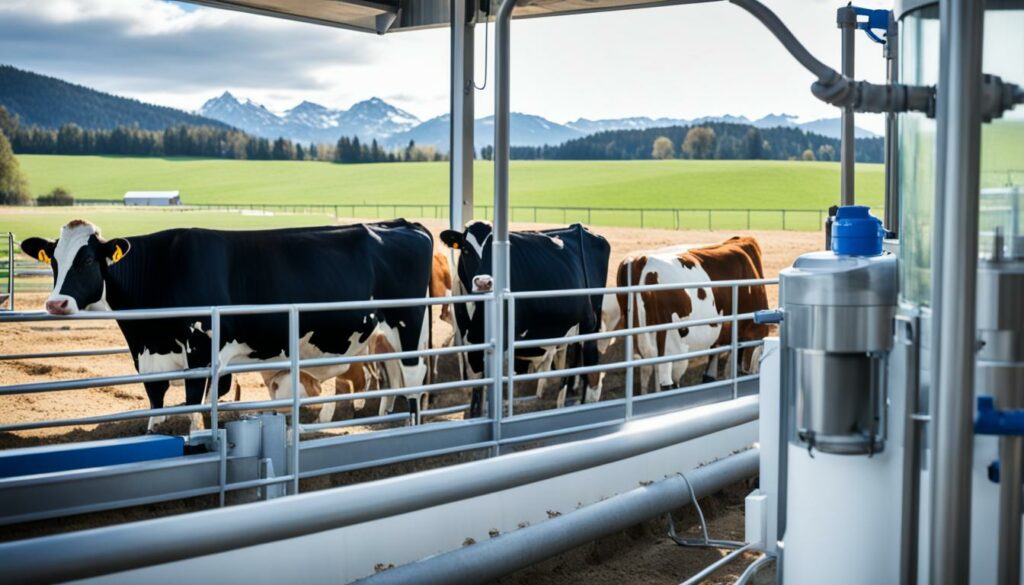
In Tennessee, by 2022, 28 AMS units were in use across eight dairies. Each dairy had about 3.5 units. This shows the importance of planning for the right number of units for your herd. AMS units must be regularly maintained to avoid problems. They need cleaning daily and can stop working properly if neglected. Each brand has its own maintenance needs, but service contracts can make this easier.
After switching to AMS, milk production rises by 3% per unit. On average, cows are milked 2.4 to 2.6 times a day. However, the effect on somatic cell count (SCC) can vary, showing the need for good milk quality control.
Transitioning to AMS also affects how farmers prepare cows and spot mastitis. It can affect cow fertility, lowering the chance of conception in Holstein-Friesian cows by 12-18%. Cows also have different lactation patterns, up to a 23% difference. It’s critical to manage cow teat health for avoiding infections.
Gleaning insights from various studies:
| Factor | Effect |
|---|---|
| AMS installation | Increase in profitability by 92.7% |
| Milk Production | 3% increase |
| Milking Frequency | 2.4 to 2.6 per cow per day |
| Profitability | 17% higher with AMS |
Looking closer at adopting automatic milking systems, these challenges stress the need for good planning and flexibility. This is crucial for a successful and lasting switch to AMS.
When we talk about AMS vs. traditional farming, there are key differences to note. Automated milking systems offer big steps forward. But they also bring their own challenges.
Compared to traditional milking, AMS shines in efficiency and productivity. Studies by experts like Bijl (2007) and Lessire (2020) back this up. They found that AMS can milk more often, leading to higher milk production. This boosts a farm’s overall performance.
AMS also means your cows get milked without needing more workers. This helps the cows and increases how much milk you get.
AMS means you don’t need as many people working on your farm. Hansen & Stræte (2020) found that this change makes dairy farmers happier at work.
Farmers can now focus more on looking after their animals and running their farms well. This shift has shaved off 20% of work hours on some farms. It makes farms work better overall.
But, getting an AMS means spending a lot at the start and later on to keep it going. Studies, like by Calcante et al. (2016), show these heavy costs. They cover buying the system and then keeping it in good shape.
However, over time, the benefits can be more than the costs. This is mostly due to how much more milk and how many other efficiencies you get.
Piwczyński et al. (2020) proved that AMS can even make cows have babies more easily. Plus, more and more farms all over the world are choosing AMS. This shows the trust in AMS to make dairy farming better.
Both AMS and traditional ways of milking have their good and bad points. AMS boosts efficiency and job happiness a lot. But you can’t forget about the cost. Still, many farmers see the overall good points of AMS for their farm’s future.
The field of robotic dairy farming is evolving quickly, making milking systems more effective and efficient. Robotic milking systems, also known as automatic milking systems (AMS), are changing the game. They make dairy farming smoother, less costly, and more productive. The increasing use of milking robots shows how they are revolutionising the industry.
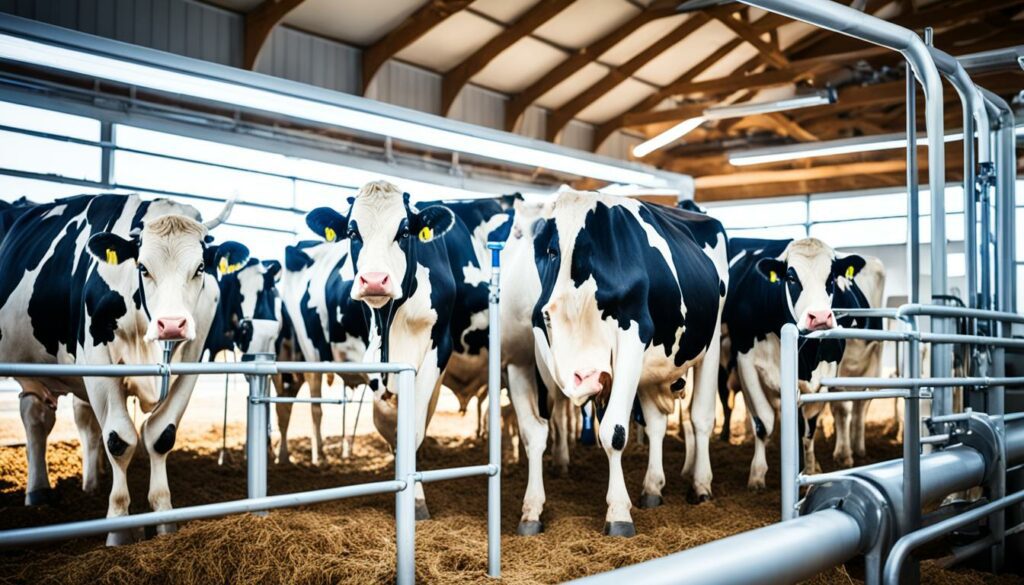
Companies making these systems are seeing more and more success. This is because many farms see the benefits of using robots. These technologies are not just about milking. They also help increase milk production and make cows happier by allowing milking at their preferred times.
Along with better milking, latest technologies are improving how we monitor cows’ health and productivity. This data gives farmers important information for managing their herds better. It helps them make smarter decisions on their farms.
Robotic milking allows for non-stop milking, which reduces stress on cows. This means farmers can focus on other important jobs. The systems also spot any issues with the milk, improving its quality and safety.
As farmers adopt these technologies, they stay ahead in the farming world. These investments are costly at first. But in the long run, they save money, boost productivity, and improve how animals are treated.
The dairy world is changing fast thanks to new technology. Smart farming and the Internet of Things (IoT) are leading the charge. With these new tools, farmers can improve how they work. They can use smart tools and data to farm with more precision.
Precision farming means using the latest tech in dairy farming. It includes smart sensors and robots. These tools help farmers keep a close eye on their cows and milk them better. Robots are now milking cows, making things more consistent and efficient than ever before. This shift towards precision farming is boosting profits and the health of the animals.
Connecting things through the Internet of Things (IoT) is making farming smarter. Now, cows wear smart collars that track their health and activities. This information is key for making better decisions and farming operations. Thanks to real-time data and smart insights, farmers are improving how they care for their cows. This leads to happier, healthier animals and more milk.
The way we dairy production methods milk cows has changed a lot. We used to do it by hand, and now we have machines doing the work. Before, we needed someone there at all times. But now, Automated Milking Systems (AMS) can milk cows any time without help. This shift has made milking more flexible, better for the cows, and we get more milk.
AMS is turning out to be a good choice for farmers in the Netherlands. It’s proving to be economically smart because it means milking more often but using less human labour. The technology is still developing, showing it could be even better when cows are out on the fields.
| Aspect | Traditional Milking | Automated Milking Systems (AMS) |
|---|---|---|
| Labour Requirements | High | Low |
| Milking Frequency | Fixed intervals, limited | Flexible, more frequent |
| Initial Investment | Moderate | High |
| Maintenance Costs | Lower ongoing costs | Higher ongoing costs |
| Productivity | Consistent but lower yield | Higher yield due to frequent milking |
| Cow Welfare | Dependent on human management | Improved, with more natural rhythms |
Working with cows is also safer and better with AMS. A study in Finland found that farmers had an easier time with AMS, and they were happier with their jobs. AMS also seems to help cows get pregnant more easily, showing it’s good for them too.
Choosing AMS means spending more money at first. But the benefits are worth it, with more milk and less need for people to work the farm. AMS could be the key to a successful and sustainable dairy farm future.
Deciding between dairy production methods is about what works best for the farm’s goals and set-up. AMS is changing how dairy farms work, making things better for everyone involved.
Automation in dairy farming has both good and bad effects on the environment. Sustainable dairy farming changes with the rise of automated milking systems. In Norway, the use of these systems for milking cows increased from 47% in 2018 to 57% in 2020.
With AMS, farms are getting bigger and using more energy-rich feeds. This can mean more milk from each cow. But it also adds to the environmental effects of automation. An important issue is the more energy these systems use. This can cancel out some of the good they do for the planet.
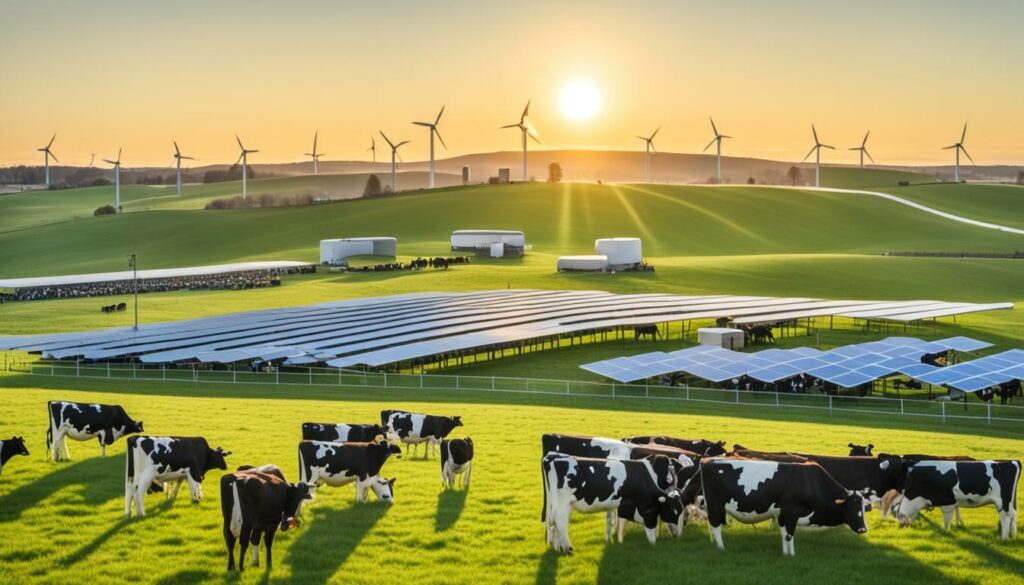
AMS’s effect on the environment isn’t all good. They often mean cows graze less because of more high-energy feeds. This change can mess up natural farm cycles. It also means more farming from outside sources, which can hurt the environment more and make farming less sustainable. Not to mention, while AMS makes some things easier, it doesn’t always help reduce harmful greenhouse gases.
To have a real benefit for the environment, sustainable dairy farming using AMS needs careful work. Saving resources and using less energy is crucial. As AMS technology gets better, it’s important to keep our wider green goals in mind. In doing so, we can enhance sustainability in the long run.
The dairy industry is moving forward, with automation at its heart. This change is not just for now but will mark the future of dairy farming. It brings benefits both in money and how farms are run.
New technologies in dairy farming keep coming, aiming to make milking more efficient. Automated milking systems (AMS) use different sensors to keep an eye on each cow’s health and how much milk they produce. With these tools, farmers can care better for their animals and get more milk.
Research shows that using automatic milking systems greatly affects cows and farming. It looks at how often cows milk when they have these systems, especially when they can also graze freely. This research helps find the best mix of automatic milking and traditional ways, showing a new direction for farming that mixes tech with nature.
The market for automated milking machines is set to grow a lot. The push comes from needing less work and wanting more flexibility on farms. The technology has become advanced enough to make putting in these systems worth the cost, changing how the dairy industry works. An example is how automatic milking helped Dutch farms make more money, showing it as a good investment.
Also, studies have looked into how much AMS helps farmers enjoy their work. Better safety at work and doing less hard physical work make the job better. The continued growth in technology and management support means AMS keep getting better. They’re working on using less energy and being more cost-effective.
In the future, as automated milking machines get smarter, dairy farming trends will move towards better productivity and caring for the animals and the environment.
| Aspect | Impact |
|---|---|
| Economic Impact | Positive ROI in Dutch dairy farms |
| Job Satisfaction | Improved occupational health and safety |
| Milk Production | Increased yield with automated systems |
| Animal Welfare | Enhanced monitoring and management |
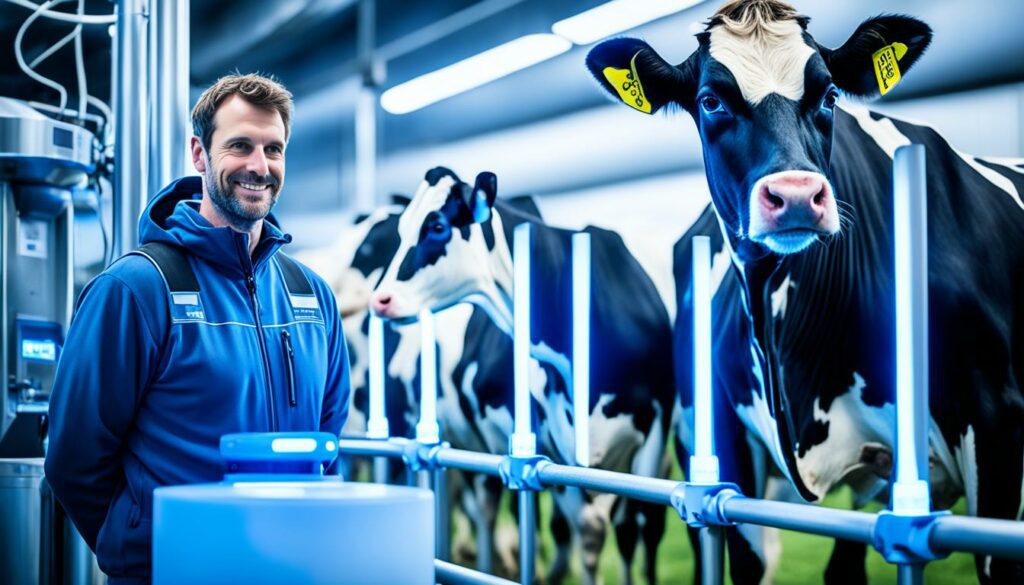
As more farmers explore automated milking systems (AMS), it’s key to answer their questions. This guide aims to clear up common doubts with facts and insights from farms around the globe.
How many cows can a single robot milk? A robot can handle 60-70 cows daily. It milks them three times a day. This boosts barn efficiency, especially for those managing large groups of up to 280 cows.
What is the typical milking time per cow in a robotic system? Cows spend 6-7 minutes in the robot per milking. The speed is good for cows and dairy productivity.
What are the maintenance and utility costs associated with AMS? Maintenance costs without labour hit about $4,000 a year. Robots need special set-ups, including various utilities and specific planning. It’s key for a smooth operation to factor in all these costs.
How close do the robot boxes need to be to the tank? Robot boxes need to be within 650 feet of the tank. This setup cuts down operation costs and boosts efficiency in managing the dairy.
Is it better to lease or buy the robots? Deciding between leasing and buying depends on your farm’s financial plan. Leasing lowers initial costs, while buying could save money long-term.
Which robotic milking system provides the best performance? The Lely Astronaut A5 stands out for its milking efficiency. It can milk up to 60 cows daily. Studies show Lely’s systems can get 10% more milk than traditional ones and 3.5% more than other robots.
Using automated milking can really change dairy farming. Being well-informed by asking the right questions is essential. It helps farmers get the most from their systems and deal with challenges.
Automated milking systems (AMS) are changing dairy farming. They bring big improvements in how farms work, manage data, and care for their animals. Looking ahead, it’s clear that using dairy tech is a must. It helps farms deal with money and staffing issues that are getting bigger.
Studies have shown that AMS are good for making money and bring lots of other benefits too. The Journal of Dairy Science found, since 2007, that AMS has made Dutch dairy farms more profitable. In 2020, Animals journal said AMS are great because they let you milk more often, showing they are efficient. And in Tennessee, AMS use has grown a lot since the first one was set up in 2017 (Palmer, 2022).
AMS has also made looking after cows better. A study in the Journal of Dairy Science in 2012 talked about this. This tech lets farmers be kinder to their cows while helping them make more milk. Although there’s a bit of difference in some milk health measures, the overall benefits are clear. Farms see about a 3% rise in milk from each system (Castro et al., 2012).
To move dairy farming forward, combining these advanced milking systems wisely is key. We need to use these new tools smartly. This way, we make sure that each farm’s needs are met and AMS can really change farming for the better.
An Automated Milking System (AMS), or robotic milking machines, makes milking cows easier. They use robots and data to milk cows. This technology also helps with cow health and tracking milk.
Automatic milking means less work for farmers. It’s good for the cows and the farm. These machines get more milk from cows and let farmers do other important jobs.
Setting up AMS is costly, but it can save money on labour and boost milk production. Farm owners should do a financial check to see if it’s worth it.
These machines have smart sensors that track how much milk cows make, their health, and when they’re milked. This information helps farmers look after their cows and farms better.
Switching to AMS means farmers need to plan well. They must think about the health of their cows, system maintenance, and expansion. These need solid management to overcome.
AMS is better at milking than older ways. It needs less work, makes more milk, and keeps cows healthier. But, it costs more to set up and look after.
AMS increases cow happiness and health by making milking easier and gentler. It also tracks cow health all the time, helping farmers take care of them better.
Yes, AMS works well with other automatic farming tools. Together, they make the farm run better and help manage everything easily.
New tech is making AMS even better. It’s more accurate, uses data smarter, and works well with other farming tech. This means happier cows and more efficient farms.
AMS helps farms use resources better, cuts down on work, and makes cows happier. Still, it’s important to think about how these systems affect the planet over time.